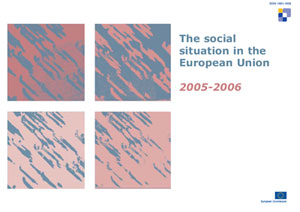 |
THE SOCIAL SITUATION IN THE EUROPEAN
UNION 2005-2006
The Balance between Generations in an Ageing Europe
European Commission, 2007, 176 pages
|
http://epp.eurostat.ec.europa.eu/cache/ITY_OFFPUB/KE-AG-06-001/EN/KE-AG-06-001-EN.PDF
Доклад о социальной ситуации в Европейском союзе издается
ежегодно с 2000 года. Его цель - информировать о проблемах социальной
политики, представлять ключевые данные и их анализ. Доклад делится
на две части. Первая часть посвящена специальной теме, которая исследуется
более подробно и глубоко. Специальная тема выпуска 2005-2006 годов
- Баланс между поколениями в стареющей Европе. Вторая часть содержит
статистические обзоры по всему кругу проблем социальной политики.
В Приложении приведены таблицы ключевых показателей.
Table of Contents
1. Introduction
Overview: Intergenerational balances and the demographic
challenge
2. Demographic and societal trends: the end of the demographic
dividend
2.1. Ageing will soon result in shrinking labour forces
2.2. Family and household patterns are being influenced by changing
attitudes and life styles
2.3. Young people stay longer in the parental home
2.4. Older people are more likely to live alone or in institutions
2.5. Fertility appears to be linked to the ability to reconcile
careers and family life
2.6. The shift of the two-breadwinner model is not yet reflected
in the time-use patterns of women and men
3. Income, health and living conditions
3.1. Life satisfaction depends on the financial situation, but
not exclusively
3.2. Prime-aged adults and families are facing a difficult financial
situation
3.3. In most Member States families with several children face a
higher risk of poverty
3.4. Redistribution greatly reduces poverty risks for families with
children
3.5. A lack of affordable housing may represent an obstacle to family
formation
3.6. In some of the new Member States more than 60% of the budget
is tied up for spending on essential items
3.7. Older people are the main users of health and social care
Part 1: The demographic and social context
1. Demographic and societal trends and their impact on the intergenerational
balance
1.1. The extension of life expectancy
1.2. The fertility swing and its implications
1.3. The driving forces behind European ageing
1.4. The contribution of legal immigration to a better intergenerational
balance
2. Income, health and living conditions
2.1. Incomes
2.2. Social policies
Part 2: Areas of social policy concern: Statistical
portraits
1. Economic situation
2. Demography, households and families
3. Ageing of the population
4. International migration and asylum
5. Education and its outcomes
6. Lifelong learning
7. Employment
8. Unemployment
9. Social protection expenditure and receipts
10. Social benefits
11. Labour market policy expenditure
12. Income distribution
13. Low-income households
14. Jobless households and low wages
15. Women and men in decision-making
16. Earnings of women and men
17. Life and health expectancies
18. Accidents and work-related health problems
Annexes
Annexe 1.1: Key social indicators per geopolitical entity
Annexe 1.2: Key indicators per geopolitical entity
Annexe 1.3: Other statistical tables per geopolitical entity
Annexe 2: Symbols, country codes and country groupings, other abbreviations
and acronyms
|

